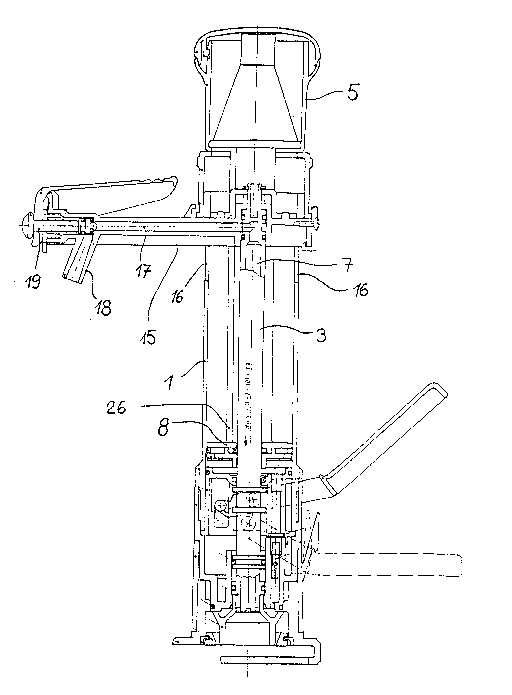Une partie des informations de ce site Web a été fournie par des sources externes. Le gouvernement du Canada n'assume aucune responsabilité concernant la précision, l'actualité ou la fiabilité des informations fournies par les sources externes. Les utilisateurs qui désirent employer cette information devraient consulter directement la source des informations. Le contenu fourni par les sources externes n'est pas assujetti aux exigences sur les langues officielles, la protection des renseignements personnels et l'accessibilité.
L'apparition de différences dans le texte et l'image des Revendications et de l'Abrégé dépend du moment auquel le document est publié. Les textes des Revendications et de l'Abrégé sont affichés :
| (12) Demande de brevet: | (11) CA 2075665 |
|---|---|
| (54) Titre français: | ROBINET DE TONNELET |
| (54) Titre anglais: | KEG TAP |
| Statut: | Réputée abandonnée et au-delà du délai pour le rétablissement - en attente de la réponse à l’avis de communication rejetée |
| (51) Classification internationale des brevets (CIB): |
|
|---|---|
| (72) Inventeurs : |
|
| (73) Titulaires : |
|
| (71) Demandeurs : | |
| (74) Agent: | MARKS & CLERK |
| (74) Co-agent: | |
| (45) Délivré: | |
| (22) Date de dépôt: | 1992-08-10 |
| (41) Mise à la disponibilité du public: | 1993-02-23 |
| Licence disponible: | S.O. |
| Cédé au domaine public: | S.O. |
| (25) Langue des documents déposés: | Anglais |
| Traité de coopération en matière de brevets (PCT): | Non |
|---|
| (30) Données de priorité de la demande: | ||||||
|---|---|---|---|---|---|---|
|
ABSTRACT
The present invention provides a keg tap for
dispensing a liquid standing under pressure from a
container provided with a keg closure, comprising a
housing surrounding a pressure chamber through which
is inserted an axially movable valve-opening rod,
co-operating with the keg closure, which, on an end
projecting beyond a housing wall, is made as valve-
opening element and is connected with an operating
element, the housing (1) being substantially
cylindrical, and the valve-opening rod (3) passing
through the housing (1) has a continuous liquid
passage (7) in the valve-opening element (4) opening
outwardly which, on its opposite-lying end, passes
over into a liquid canal (17), arranged substantially
at right-angles to the liquid passage (7) which is cut
out of a bracket (15) inserted through a recess (16)
in the wall of the housing (1) and has an outlet (18)
for the liquid closable with a closure valve (19), the
bracket (15) and the valve-opening rod (3) being
jointly raised and lowered, wherein, in the lower end
of the housing (1) is provided an insert (2) through
which passes the valve-opening rod (3) and in which
bores are arranged on holding elements into which
project pins (6) of a fixable lever (10) provided with
a fork (9), whereby, close to the bores of the insert
(2), on the valve-opening rod (3) are formed an upper
and a lower flange (11,11') between which also
opposite-lying pins (6') engage the fork (9) and
whereby the valve-opening rod (3) is upwardly and
downwardly movable with the help of the lever (10)
and, on the lower end of the housing (1), is pushed
on and fixed a sleeve (13) partly encompassing this,
the housing (1), insert (2) and sleeve (13) thereby
having slots, lying laterally next to the valve-opening
rod (3), in which the fork (9) of the lever (10) is
guided, holding elements (14) for securing the tap on
the keg being formed on the sleeve (13).
Note : Les revendications sont présentées dans la langue officielle dans laquelle elles ont été soumises.
Note : Les descriptions sont présentées dans la langue officielle dans laquelle elles ont été soumises.

2024-08-01 : Dans le cadre de la transition vers les Brevets de nouvelle génération (BNG), la base de données sur les brevets canadiens (BDBC) contient désormais un Historique d'événement plus détaillé, qui reproduit le Journal des événements de notre nouvelle solution interne.
Veuillez noter que les événements débutant par « Inactive : » se réfèrent à des événements qui ne sont plus utilisés dans notre nouvelle solution interne.
Pour une meilleure compréhension de l'état de la demande ou brevet qui figure sur cette page, la rubrique Mise en garde , et les descriptions de Brevet , Historique d'événement , Taxes périodiques et Historique des paiements devraient être consultées.
| Description | Date |
|---|---|
| Le délai pour l'annulation est expiré | 2000-08-10 |
| Demande non rétablie avant l'échéance | 2000-08-10 |
| Réputée abandonnée - omission de répondre à un avis sur les taxes pour le maintien en état | 1999-08-10 |
| Inactive : Abandon.-RE+surtaxe impayées-Corr envoyée | 1999-08-10 |
| Demande publiée (accessible au public) | 1993-02-23 |
| Date d'abandonnement | Raison | Date de rétablissement |
|---|---|---|
| 1999-08-10 |
Le dernier paiement a été reçu le
Avis : Si le paiement en totalité n'a pas été reçu au plus tard à la date indiquée, une taxe supplémentaire peut être imposée, soit une des taxes suivantes :
Veuillez vous référer à la page web des taxes sur les brevets de l'OPIC pour voir tous les montants actuels des taxes.
| Type de taxes | Anniversaire | Échéance | Date payée |
|---|---|---|---|
| TM (demande, 5e anniv.) - générale | 05 | 1997-08-11 | 1997-06-03 |
| TM (demande, 6e anniv.) - générale | 06 | 1998-08-10 | 1998-06-16 |
| TM (demande, 2e anniv.) - générale | 02 | 1994-08-10 |
Les titulaires actuels et antérieures au dossier sont affichés en ordre alphabétique.
| Titulaires actuels au dossier |
|---|
| R.T.C. LIMITED |
| Titulaires antérieures au dossier |
|---|
| J. DIGBY HUBBARD |